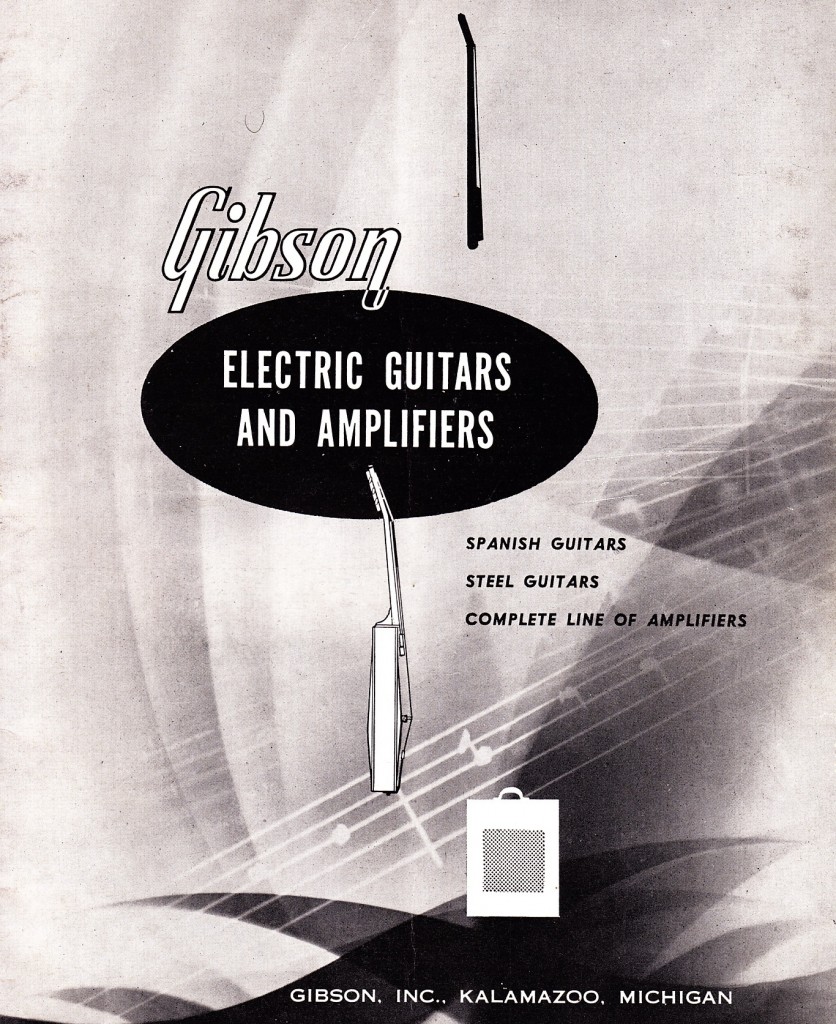 Download the twenty-page 1956 Gibson Electric Guitars and Amplifiers Catalog:
Download the twenty-page 1956 Gibson Electric Guitars and Amplifiers Catalog:
DOWNLOAD: Gibson_Elec_1956_cat
Products covered, with text, specs, and photos, include: Gibson Super 400 CESN, L-5 CESN, ES-5 Switchmaster, Byrdland, ES-175, ES-175 DN, ES-350T, ES-125, ES-295, and ES-240 hollow-body electric guitars, Gibson GA-90, GA-77, GA-55 V, GA-70, GA-40 ‘Les Paul,’ GA-30, GA-20, GA-6, GA-9, and Gibsonette amplifiers; Gibson Les Paul Custom, Les Paul, Les Paul special, Les Paul Junior, and ES-225 electric guitars; Gibson J-160 E acoustic/electric, EM-150 electric mandolin, Gibson Electric Bass; Ultratone, Century, BR-6, Console Grande, Consolette, Electraharp, and Multiharp steel guitars, plus more.
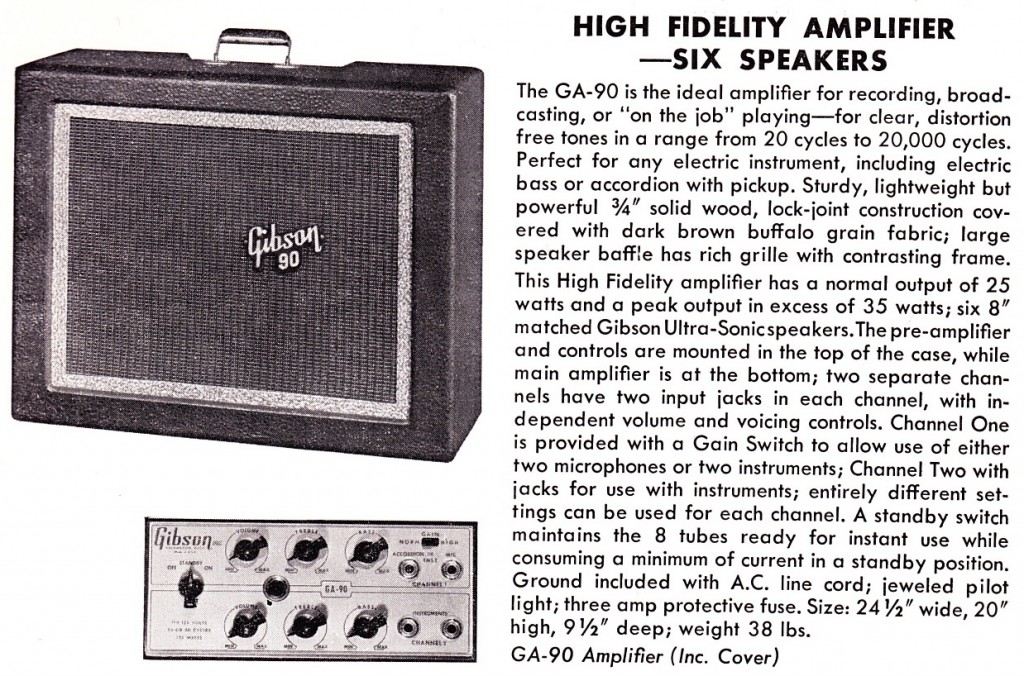 The 1956 GA-90 ‘High-Fidelity Amplifier,’ with six 8″ speakers and promised 20-20K hz frequency response (really?).
The 1956 GA-90 ‘High-Fidelity Amplifier,’ with six 8″ speakers and promised 20-20K hz frequency response (really?).
This very rare catalog is something special for fans of the electric guitar. We see a number of trends developing – the solidbody electric guitar, ‘true vibrato’ circuits in amplifiers, high-wattage amps… and a few notably absent: humbucking pickups and amplifier reverb. These were right around the bend though… Download and enjoy.
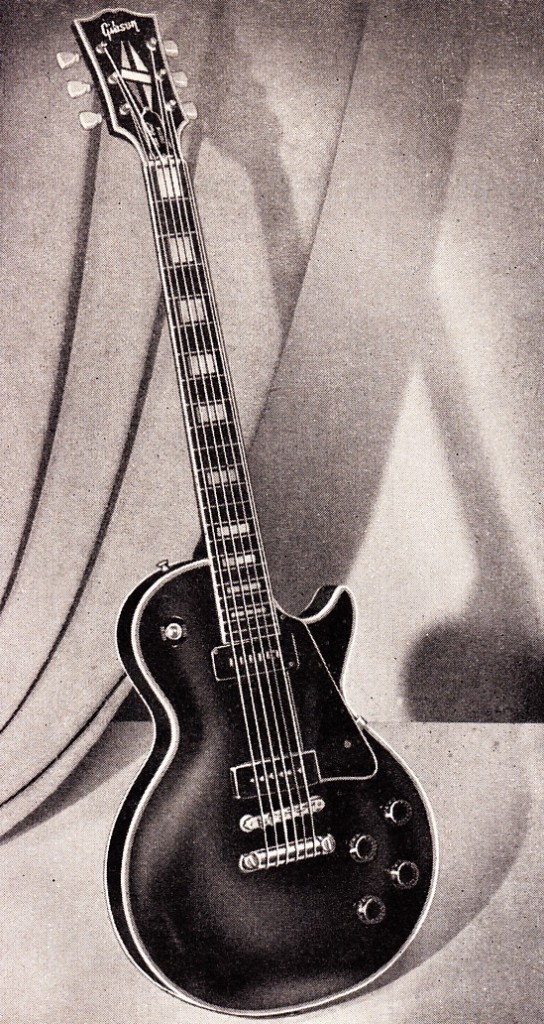 Original catalog image of the 1956 Gibson Les Paul Custom
Original catalog image of the 1956 Gibson Les Paul Custom
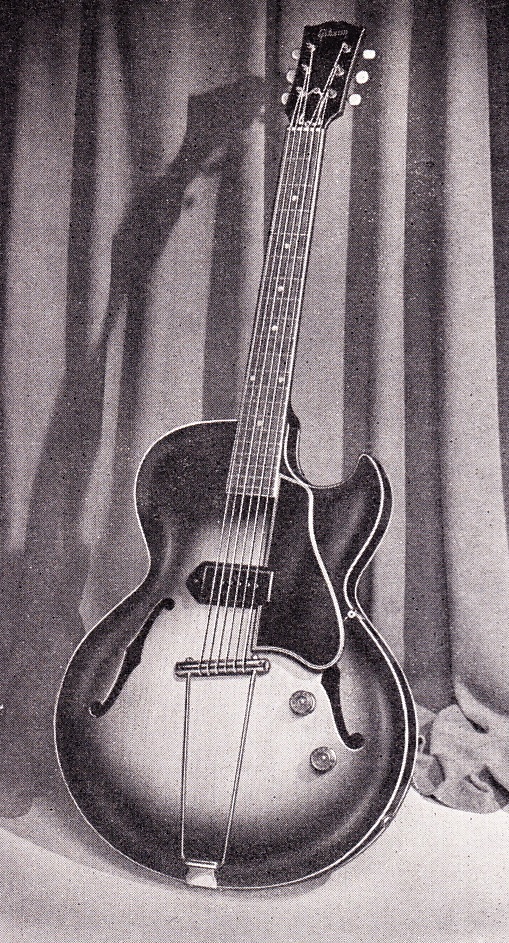 Gibson’s 1956 ES-225T, the first of their many semi-hollow body guitars, the most iconic of which is the ES-335. I borrowed a friend’s ES-225T for a few weeks in high school and I still have very fond memories of it… great guitars, very expensive today.
Gibson’s 1956 ES-225T, the first of their many semi-hollow body guitars, the most iconic of which is the ES-335. I borrowed a friend’s ES-225T for a few weeks in high school and I still have very fond memories of it… great guitars, very expensive today.
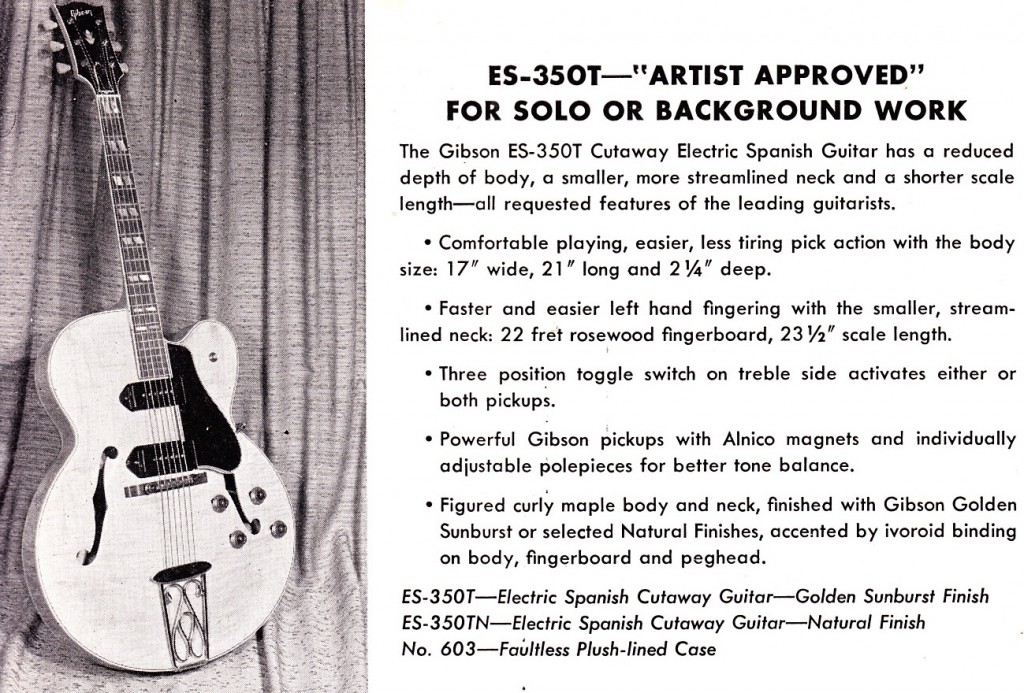 The 1956 Gibson 350T. A slightly less-fancy Byrdland, also with a medium-scale neck.
The 1956 Gibson 350T. A slightly less-fancy Byrdland, also with a medium-scale neck.
The 1956 Gibson ES-140, their short-scale offering of the era. An artist whom I regularly work with at Gold Coast Recorders often brings one of these to sessions, and it is a seriously fun sitting-on-the-couch guitar with a seriously noisy single-coil pickup.
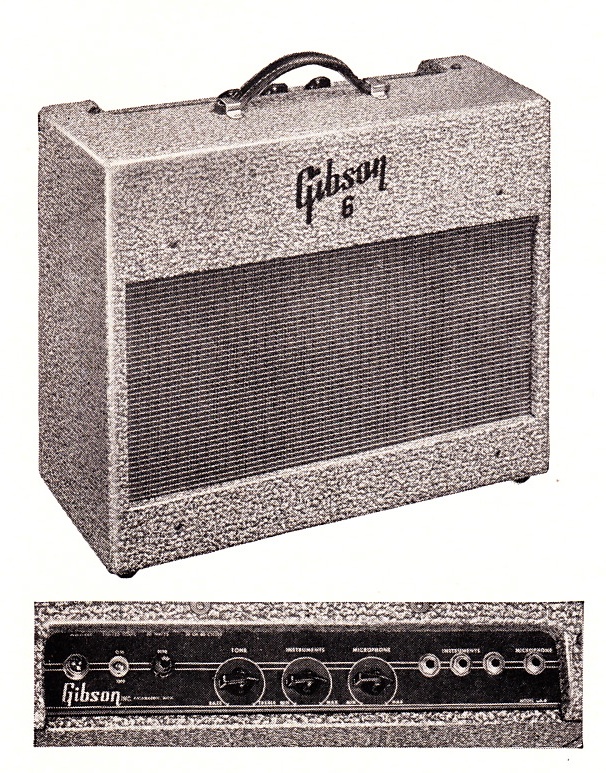 The 1956 Gibson GA-6, one of their most classic amps. Very similar to a Tweed Fender Deluxe. Fantastic amplifier.
The 1956 Gibson GA-6, one of their most classic amps. Very similar to a Tweed Fender Deluxe. Fantastic amplifier.
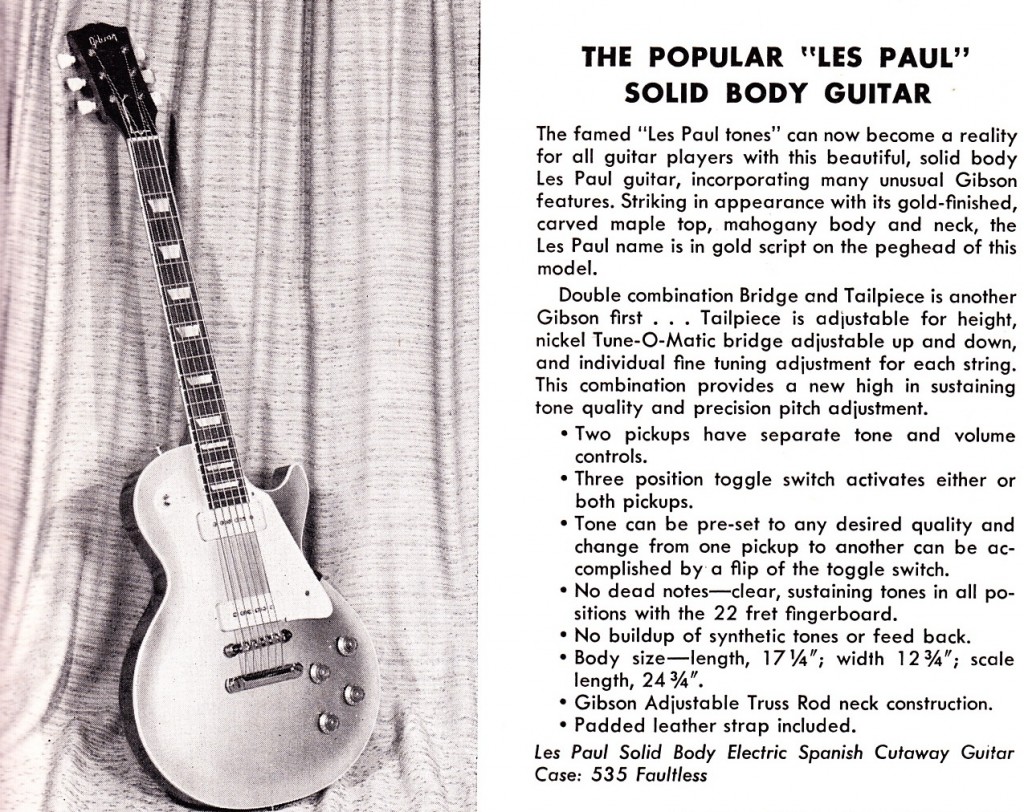 The 1956 Gibson Les Paul. We have a clone of one of these (based on a 1972 Gibson Les Paul Deluxe) at Gold Coast Recorders and it sounds great. 1956 was an important year in the development of the Les Paul as it marked the appearance of the tune-a-matic bridge: it was now possible to intonate your guitar quickly and accurately, AND also customize the string feel and sustain characteristic by setting the stud to get the break angle that you want.
The 1956 Gibson Les Paul. We have a clone of one of these (based on a 1972 Gibson Les Paul Deluxe) at Gold Coast Recorders and it sounds great. 1956 was an important year in the development of the Les Paul as it marked the appearance of the tune-a-matic bridge: it was now possible to intonate your guitar quickly and accurately, AND also customize the string feel and sustain characteristic by setting the stud to get the break angle that you want.
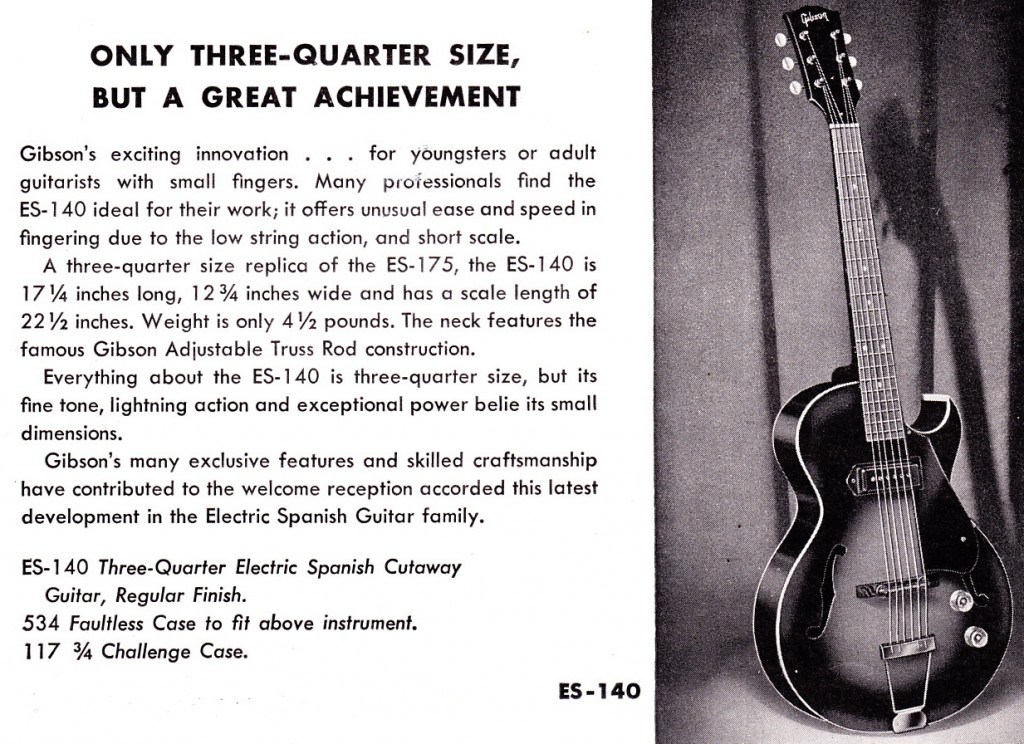
8 replies on “Gibson Electric Guitars and Amplifiers 1956”
Gibson amps were technically innovative, but the designers were still under the idea that they were building an amplifier and not a sound modifier. That was appropriate for the jazz and country and big-band/dance/casuals/pop sounds they loved-and which really constituted what their market then wanted-but when hard rock and modern rock guitar came out they were hopelessly out of what the young buyers wanted. Leo Fender was also of this persuasion personally but on the West Coast he had people like Dick Dale around, and that made a difference. A big one.
From a tech standpoint, though, the Gibson amps were a disaster. They were built like an ARRL Handbook project, or worse-parts everywhere, point to point. Ruggedness was not there. Fender got it right, he basically adopted a poor man’s military style of construction-he might have copied McIntosh too-and every other amp was a copy of a Fender once or twice removed after that. It also doesn’t help that Gibson followed the hi-fi trends endorsed in the books and manufacturer literature we see discussed here, and used the latest tubes and popular circuit variations. Leo stuck with a few tube types because they held up well and because music stores had them and would continue to. Players avoided Gibson amps not only because Fenders sounded the way they liked, and were rugged, but because techs promoted them and because if you needed a tube all the music stores had them. You didn’t need to hunt TV repair shops and jukebox places for the odd ones.
And there was another Fender advantage: Fenders all had single coil pickups and therefore lower output. Fender designed his amps for that so when you plugged a humbucker guitar into a Fender amp overdrive became easier. Leo hadn’t wanted that, but that was rock and roll. A Fender amp and a Gibson guitar made a pretty good pair. The other way around, not so much.
As for the Les Paul guitar: I’ve always had a tech’s snooty contempt for them because Les Paul himself NEVER played a guitar like a production Les Paul. His were like the factory ones in shape only. Of course, in the late sixties Gibson DID make one like he really played, the low impedance models. No one wanted it.
Still, they would be way better guitars if Gibson had used a laminated neck and if they had done a better job selecting wood so that most post-’68 Pauls didn’t weigh a short ton, ruining their tonal qualities and hunchbacking their players. The old Bursts weren’t so much great guitars as the later ones were dull, overweight boat anchors.
The situation has improved, but, I still love to remind people that Jimmy Page sold a LOT of Les Pauls with his humbucker-swapped Telecaster!
I’m not very technical, but my 1957 GA-40, 1959 GA-18, 1960 GA-20 all sound wonderful, and distinctly different than Fender amps – in a good way. It appears to me they use basically the same circuits as Fender, but some different brands of components which are arranged differently, and the redwood cabinets color the sound too. Fender players seem to love them, and many rock musicians use them for recording (ie: Duane Allman, Ry Cooder, etc.). I prefer my LP specials – the maple cap on Standards does not improve the sound to my ears. Les Paul preferred not having a maple cap on his guitars, so the first version of the three pickup “black beauty fretless wonder” was all mahogany, with no maple cap. The maple cap adds weight, and alters the sound in a way that doesn’t improve it to my ear, so I prefer Specials and SG’s for being lighter and having a brighter sound more suited to humbuckers, while they sound great with p-90’s too. The wood vibrations between the maple cap and mahogany body are slightly different, so they sort of (just guessing) cancel each other out perhaps? The all mahogany solid body Gibson guitars seem to vibrate better, but maybe I’ve never had a good Standard.
Yes, the Les Paul mystique is 99% horseshit, especially because it has nothing to do with what Les _actually did_ invent. “The Les Paul sound”, meaning a heavy solidbody guitar with humbucker pickups driving a Fender amp, a universe away from Les Paul’s guitar sound, which is clean, steel-guitar like, jazzy.
He made his own guitars, they said Gibson and had his shape, that’s all. Les used low impedance pickups from the start and went direct into the PA or recording board. His playing was nothing like rock guitar, and his music was nothing like rock or country music: it was a vaudeville sound, Tin Pan Alley Lite. He could have backed up Frank Sinatra, Judy Garland or Sarah Vaughn, and jazz men considered him a first rate guitarist playing pop stand music, a six string Myron Floren.
But Paul was so much more than a player, he invented the technology: yet, his implementation of it was utterly different than what we have today, sort of like a German vs. Boehm keyed clarinet. Both are the same instrument but a player trained on one can not play the other. He could hardly work in a regular studio, and no one else could run his.
The hardware of rock owes little to Les, for better or worse. The pickups were Seth Lover, the amps Leo Fender and several associates, and people copying them (except the Vox, which is another story)and modifying and abusing them. The studio layouts were several people, probably Ross Snyder and Putnam. I’m sure Les felt a little weird in his dotage around all these “Les Paul Players”, few of which really even had any inkling what he really did on a musical or technical level.
I’m not saying either is bad: it’s just that both were almost utterly alien to each other. But Gibson sold a lot of Les Paul guitars and he got an amount-no one has ever said how much-for each one. It was a good living.
I have a LP Recording guitar, the only reason I refuse to sell it is because some idiot would likely gut it out and butcher it into an imitation LP Standard. It weighs at least ten and a half pounds and is therefore ungigworthy, even if I did gig, which I don’t.
Guitar players never did understand the concept behind the low impedance Pauls. A normal pickup is a lumpily tuned bandpass filter, whereas the Lo Z LP gives you the whole spectrum of sound. To get a rock, country or jazz sound you have to EQ it, that was the whole idea. The Alembics with the “real Alembic” circuits (Series I or II) are the same way, except they require external power from a dedicated cable. Les intended for Gibson to sell a dedicated EQ/preamp (separately or in a combo amp) that would enable a player to get any sound he wanted easily, sort of like a 1970s Variax.
Gibson never did know how to sell guitar amps or electronics and no third part was going to invest in the low impedance concept when no one else was going to make a low impedance guitar. The design of the Lo Z LP pickups was something of a state secret, Gibson kept a tight lid on the design and made sure unpotted pickups or design info stayed in plant and they would not sell them separately. No one wanted to dissect them, the whole concept was never popular, and the guitar industry is all about popularity.
Les was a genius, he was also all about business and was a sharp operator. Gibson made him more money than his records did, and he knew when to just let the money roll in and quit trying to change things.
The biggest issue with LPs as far as setup is the neck angle, which is never the same on any two and which could use resetting on half of them. It’s a double bugger to do without leaving external evidence the guitar has been reworked.
The T-O-M bridge and tailpiece were a good idea, except the distance between them is too short to do much. A tailpiece as on the big jazz boxes would have been a better idea. And the original TOMs have all collapsed or corroded now too.
I have searched the internet for over a year and have been unable to find any information on my guitar. I have told that it is an accoustic/electric hollow body. I know that it is a Gibson ES225. The thing that I think is so unusual is that it has 4 pickups and a switch on it. It is sunburst with ivory keys. My dad bought it for my brother in the early 60’s and it was used. I believe that it was made around 1956. It is in excellent condition. Can anybody tell me how I might find out more information about this guitar? It has a beautiful sound and every one who plays it wants it!! People stop by to visit my guitar.
post a pic somewhere and send us a link. otherwise no one can help you.
I have told that it is an accoustic/electric hollow body. I know that it is a Gibson ES225. The thing that I think is so unusual is that it has 4 pickups and a switch on it. It is sunburst with ivory keys.
If it has four pickups you either have a heretofore unknown factory prototype or it has been modified. Gibs never made a four pickup guitar. The only four pickup guitars in history to my knowledge were one Burns model and a variant of the Grazioso the Beatles had that looks exactly like what you would think a Czech Strat copy would look like if you ever saw a Tatra.